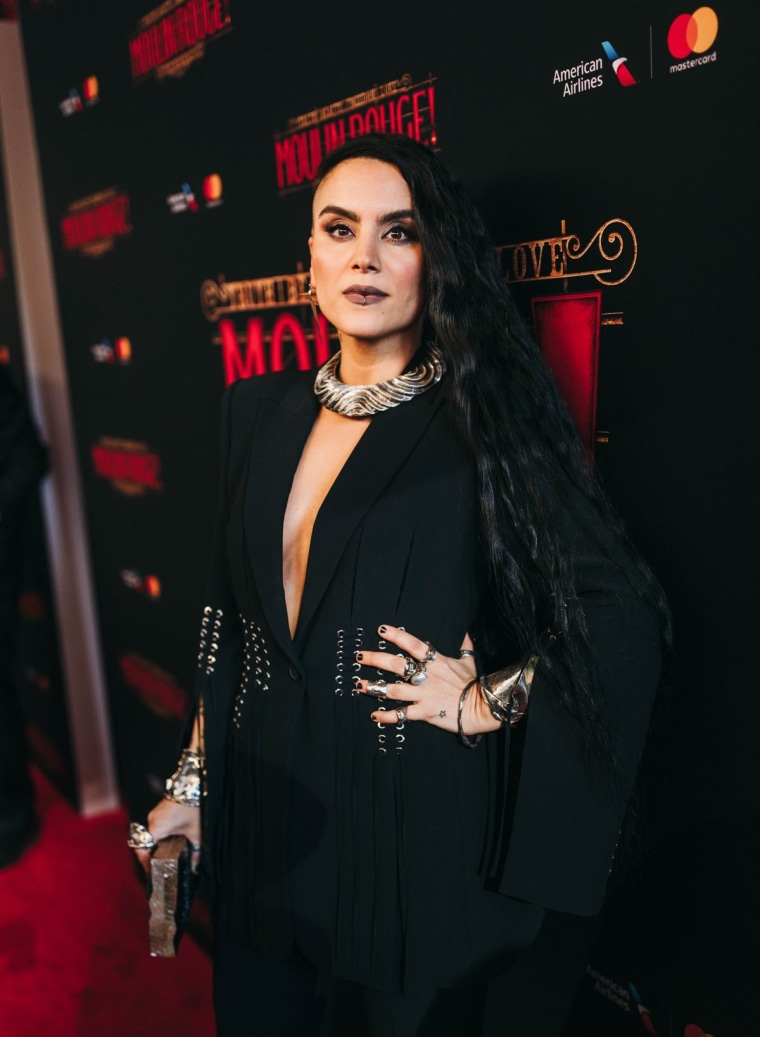When Sonya Tayeh walked into the first day of tech rehearsal — the day a show’s cast moves into the theater to practice — she was looking forward to putting the performers of Broadway's “Sing Street” through their paces. But this was March 2020, and shortly after the cast arrived, the producers sent everyone home. They were told Broadway was going dark due to the Covid-19 pandemic. In addition, her first Broadway show, “Moulin Rouge! The Musical,” was also temporarily shutting its doors.
How did the Emmy-nominated Tayeh, who had only recently made the jump from television to Broadway, handle the devastating news and survive a year without theater?
She danced, of course. But she had to get creative.

Tayeh, 44, became a household name for the distinct form of “combat jazz” she introduced to television’s “So You Think You Can Dance.” And in an industry dominated by men—only 24 percent of the Broadway shows that debuted in the 2018-2019 season had female choreographers—Tayeh lends her specific point of view to imaginative stories.
Through her unique background (as a female Palestinian, Lebanese, Arab-American, queer artist) and nontraditional introduction to the stage, Tayeh is truly opening new possibilities for all different kinds of expression and movement. Tayeh told Know Your Value that she wants theater to be designed for “all people of all color, and all genders, non-binary, all of it … I feel part of that change, part of that shift and part of that demand.”
'There has to be a place for me somewhere'
Born in Brooklyn and raised outside of Detroit in Dearborn, Michigan, Tayeh began studying traditional ballet and jazz her senior year in high school, a very late age by industry norms. Studios were filled with students who had been in dance classes since they were five or six years old, and studios that Tayeh approached turned her down, saying, “We just don’t know what to do with you.” Tayeh was undeterred.
“I just always thought that was strange,” Tayeh said, “When you fall in love with something later, how does that mean it’s ‘too late’? There has to be a place for me somewhere,” she thought. Tayeh kept calling studios until she found one that accepted her. Then Tayeh booked private lessons and took classes with younger students to try to catch up with dancers her own age.

She credited her “very loving, very driven” Arab-American family with instilling in her a sense of drive and determination to succeed. Her mother, a day care specialist and restaurant and hotel manager, especially inspired Tayeh through her focus and dedication. Her family gave her unequivocal support in everything she pursued. Though today, she often finds herself as the only Arab-American on a creative team, that was not the case when she was growing up. She found support and community through the large Arab-American population in her hometown. These influences grounded Tayeh, giving her the strength to follow her dreams.
Tayeh finally found her place under the tutelage of Diane Mancinelli at Henry Ford Community College right in Dearborn. By giving her the right books to read, the classes to take, the documentaries to watch, and the freedom to create movement, Mancinelli helped Tayeh’s “imagination explode.”
Tayeh said, “I was tired of hearing that I was late. And here was someone that told me that I was right on time.”
Finding confidence
Tayeh’s determination to make up for lost time took over, but memorizing choreography was challenging, and Tayeh’s body had limitations because she wasn’t trained at a young age. Eventually, she found the tools that worked for her, like leaving self-judgement and insecurity behind. “I wasn’t embarrassed by what I didn’t know,” Tayeh said.
She studied content from dancers and choreographers like Martha Graham and Twyla Tharp as she moved on to Wayne State University to study dance with a team of all-female professors who were creating their own movement techniques and vocabulary. “They were women who were breaking barriers by wearing their hair down and dancing aggressively. They helped push the confidence of my own voice and helped reuse what I thought were limitations as blessings,” Tayeh said.
Tayeh didn’t graduate from Wayne State until she was 25. Rather than take out student loans, she paid tuition monthly by working as a teacher, bartender and house dancer in Detroit clubs. After graduation, she headed to California where she co-directed at The Dance Company of San Francisco for several years.

She eventually made the leap to Los Angeles and threw all her energy into creating a show for Choreographers’ Carnival, an industry showcase. A talent agent in the audience loved Tayeh’s style. He added her to his talent roster the very next day, and he helped her book “So You Think You Can Dance” just three months later, leading to two Emmy nominations and opportunities to choreograph for musicians like Miley Cyrus and Florence + the Machine.
Tayeh, who refuses to be pigeonholed into any particular genre, was looking for her next challenge. Feeling exhausted by the pace of the Los Angeles dance scene, she sought opportunities that allowed her more time to collaborate and really “sit” with a script.
Her first major theatrical project was Williamstown Theatre Festival’s “The Last Goodbye,” a show that combined Shakespeare’s “Romeo and Juliet” with the music of Jeff Buckley. “I just thought, ‘whoa, this is a really interesting, weird world where different elements beautifully collide. It really sparked something in me,’” Tayeh recounted.
So when her friend and director Leigh Silverman called her to choreograph “Kung Fu,” an off-Broadway dance-play, Tayeh jumped at the opportunity to move to New York City and work in theater. Following “Kung Fu,” Tayeh made her Broadway debut with “Moulin Rouge!” and she received a Tony Award nomination for Best Choreography.

“Moulin Rouge!” director Alex Timbers told Know Your Value that Tayeh “makes our show move like no other on Broadway. It’s impossible to watch a piece Sonya’s created without being immediately blown away by her imagination, style and artistry.”
Our 'voices are getting louder. The demands are getting higher.'
Adamantly refusing to be put into any sort of box, Tayeh said she faced a lot of pushback through the years: “It was always a constant struggle of…Who are you? Pick a lane. You don’t have enough experience. Where do we place you? You have a hyperathletic and strange vocabulary.” Grounded by her supportive family, Tayeh had the energy to “bust through a lot of doors to make it.” And in the theater world, Tayeh needed that energy for extra meetings and extra rehearsals to present her ideas to creative teams more used to seeing the traditional style of Broadway movement.
Notably, Broadway performers and creatives lack diversity, making Tayeh one of the few female decision-makers—and often the only Arab-American—in the room. But she’s been immersed in theater for so long now that she has started to see a change: “I work with many female directors that I love who are badass and are shifting the game when it comes to theater. The voices are getting louder. The demands are getting higher.”
Tayeh may be a Palestinian, Lebanese, Arab-American, queer artist, and those identities all factor into her choices, but those labels do not define her. She said, “I’m not a queer choreographer. But my voice, because I am queer, could be really interesting. Because of everyone and their layers, they're able to bring so many different offerings to the table. And that's what art is. It's a colorful community of offerings that are from so many different perspectives.”
The future
After leaving the cancelled tech rehearsal for “Sing Street” in March 2020, Tayeh was devastated and scared. She said, “Because my aesthetic is a lot of partnering and intertwining bodies—things that aren’t possible in quarantine—I was really lonely. I would go up to my roof and partner myself even when it was raining.” Her craft and aesthetic shifted as she embraced the “art of loneliness.”
But because her career has been so versatile, Tayeh was able to shift direction during the pandemic, traveling to upstate New York with the American Ballet Theatre. Tayeh and the dancers quarantined together and then began building new work. She also choreographed commissioned pieces for the Manhattan’s Guggenheim Museum and the Martha Graham Dance Company.
Luckily, Broadway will return this fall. “Moulin Rouge!” will reopen on September 24, and the Tony Award winners will be announced just two days later. She's currently in Australia to help open the "Moulin Rouge!" production there. Tayeh is still awaiting news about “Sing Street,” which is tentatively scheduled to open this winter.
Regardless of the genre she works in, Tayeh will continue putting her personal stamp on dance and movement—and she urged others who feel similarly called to keep following their inner voice: “Make your voice known. If you want something, do the work to achieve it. I always say dance is my biggest heartbreak and my greatest love all at the same time. So when you have that whisper and that innate sense of drive, you find a way.”
